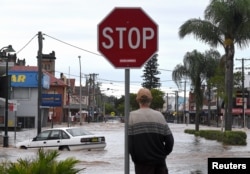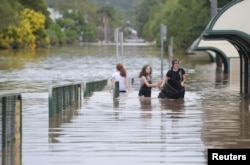Australian authorities Sunday said they found a third body in the aftermath of Cyclone Debbie and accompanying floods that swamped the country’s east coast, as receding waters start revealing the human and economic cost of the storm.
The disaster zone stretched 1,000 kilometers (600 miles) from Queensland state’s tropical resort islands and Gold Coast tourist strip to the farmlands of New South Wales state.
The body of 77-year-old Nelson Raebel was found in floodwaters in the state of Queensland on Saturday afternoon, Queensland Police said, bringing the national death toll to three since the cyclone hit Tuesday.
Authorities are searching for three people that remain missing in flood-hit areas of Queensland.
Widespread devastation
Queensland Premier Annastacia Palaszczuk said the devastation caused by the storm was huge.
“It is going to take months to repair,” she told reporters Sunday.
The Insurance Council of Australia has declared the event a catastrophe, which could cost hundreds of millions of dollars in losses.
Photos taken by emergency services in the town of Lismore, in New South Wales, show businesses in the town center inundated with brown water.
Mayor Isaac Smith, who was assessing the damage Sunday, told Reuters it resembled a war zone.
Several large rivers in New South Wales that had reached major flood levels were receding, the Australian Bureau of Meteorology (BOM) said Sunday.
Evacuations ongoing
Evacuation orders were still in place for a number of townships in the state’s north, while the city of Rockhampton in Queensland braced for record-level flooding next week, as water moves downstream into the Fitzroy River catchment.
“It’s almost the size of Texas in the U.S., it’s a huge catchment, and that’s why it can take some time for water to make its way downstream,” said meteorologist Michelle Verry from the Queensland BOM.
Verry said what remains of the cyclone has moved off Australia’s eastern coast.
Storm to slow economy
Cyclone Debbie, a category four storm, one short of the most powerful level five, pounded Queensland state Tuesday, smashing tourist resorts, bringing down power lines and shutting down coal mines.
Australia’s Defense Force was deployed to help deliver medical personnel and supplies to communities in the north of the state.
Debbie will hit Australia’s A$1.7 trillion ($1.3 trillion) economy, with economists estimating it will slow growth to less than 2 percent in the first quarter.












